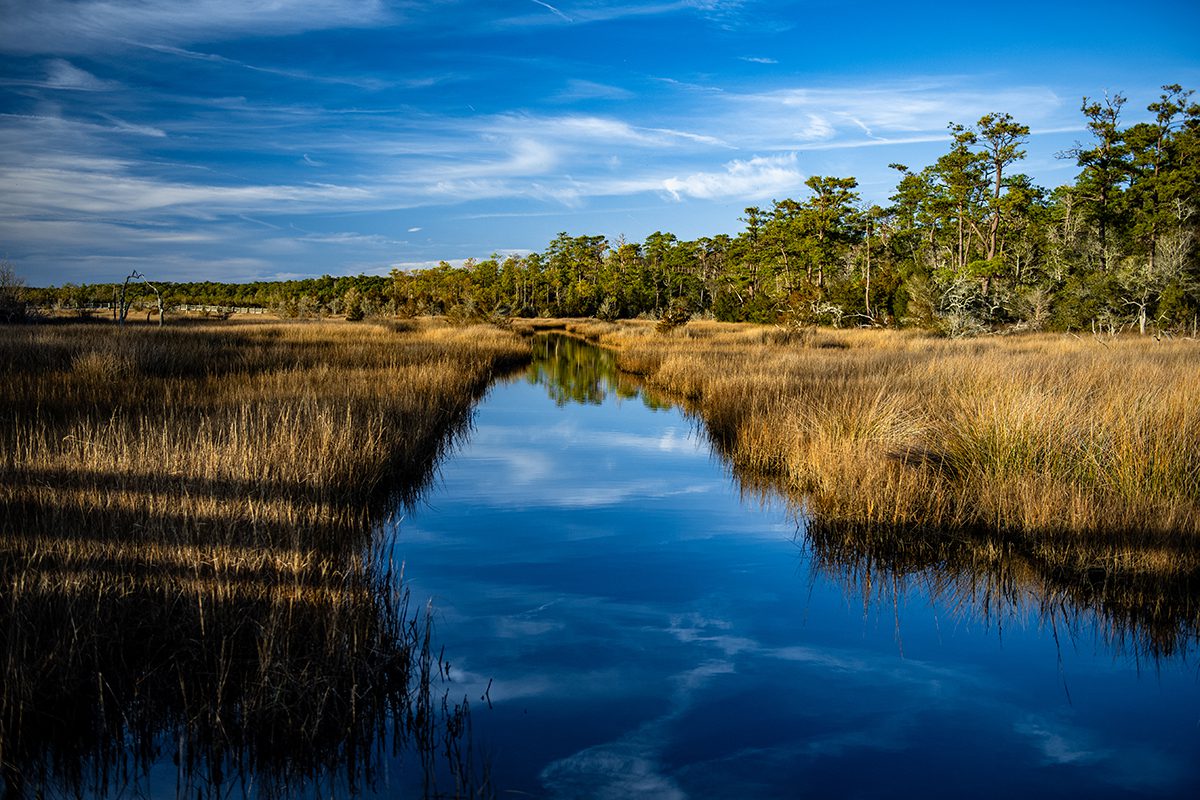
This story has been updated.
The Environmental Protection Agency on Monday announced a $421 million grant for a coalition of North Carolina and three other states working with nonprofit organizations for conservation and restoration projects that reduce carbon emissions and make communities more resilient to natural hazards.
Supporter Spotlight
The 21 proposed projects are estimated to reduce greenhouse gas emissions by 28 million metric tons by 2050. The grant includes roughly $30 million over five years for the Newport-based North Carolina Coastal Federation, which publishes Coastal Review.
North Carolina, via its Department of Natural and Cultural Resources, had applied for the Climate Pollution Reduction Grants program funding in April as part of a partnership called the Atlantic Conservation Coalition with South Carolina, Virginia, Maryland and The Nature Conservancy.
The coalition plans to use the federal money for conservation and restoration projects for peatland wetlands, coastal habitats, and forests across all four states.
The projects proposed include salt marsh restoration, farmland preservation, conservation of land for outdoor recreation, construction of living shorelines. Cost assistance could be provided to small forest landowners, trees planted in cities and reforestation work.
The coalition has identified nearly 600 tracts as both low-income or disadvantaged communities that could benefit from the funding.
Supporter Spotlight
The nearly $30 million grant to the North Carolina Coastal Federation will be used in several key areas with an overall goal of protecting and restoring approximately 595 acres of coastal habitats in North Carolina, the organization said.

“The Federation is honored to be part of this historic award,” said Coastal Federation Executive Director Braxton Davis. “This grant will enable us to undertake major projects over the next five years by first identifying the most endangered coastal habitats, and then protecting and restoring at least 600 acres. We will also engage world-class scientists to determine the long-term fate of the carbon stored by these projects, which would otherwise contribute to sea level rise if lost to the atmosphere. By preserving these invaluable habitats, we are also supporting healthy fisheries, improving water quality, and reducing damaging flooding.”
The Coastal Federation said the funding would play a critical role in protecting and restoring coastal habitats that can store vast amounts of carbon. “These vital habitats face threats from persistent erosion, adverse land usage, and increased sea levels. By preserving these vital ecosystems, the initiative ensures that the stored carbon remains sequestered, preventing it from being released into the atmosphere and exacerbating global warming,” the organization said in a statement.
“Coastal habitats are some of the most efficient natural carbon sinks on the planet,” said Davis. “This funding will enable us to protect these critical areas and enhance their ability to sequester carbon, which is an important component in our fight against climate change.”
Jacob Boyd, the Coastal Federation’s salt marsh program director, noted that the collaboration among federal agencies, state governments and nonprofits sets a precedent for climate action.

“This is a model for not only how we can use natural infrastructure to help achieve our climate goals but how we can have a much greater impact through partnerships and collaboration,” said Boyd.
Boyd said the funding includes money for Duke University in both the coalition’s budget and in money marked for the Coastal Federation for assistance with project and research management.
He said a $350,000 contract with a company called Natrx will result in real-time satellite imagery-based analysis for evaluations and selections of project sites and for monitoring.
A $1.5 million contract with the U.S. Geological Survey is for advanced research to closely monitor carbon sequestration and storage results realized by the projects. “Project consultants include specialized experts to help with project development, site selection, management, and other specialized services that are needed to complete project tasks,” Boyd said.
$4.3 billion in grants
The funding is part of more than $4.3 billion in Climate Pollution Reduction Grants to implement community-driven solutions that tackle the climate crisis, reduce air pollution, advance environmental justice, and accelerate America’s clean energy transition, EPA said.
Gov. Roy Cooper released a statement Monday, noting that the grant was one of the largest grants the EPA has awarded and the largest for nature-based climate solutions.
The statement also noted the grant’s fit with the directives in Cooper’s Executive Order 305, which set goals to conserve and restore natural and working lands by 2040, and the North Carolina Natural and Working Lands Action Plan, which the Department of Environmental Quality published in 2020.
“Protecting our natural lands for future generations is not only critical to our fight against climate change but also our state’s economy and tourism industries,” said Cooper. “This major award from the Biden-Harris administration will strengthen our bipartisan partnership to conserve and restore public and private lands across state lines.”
Each of the four states will receive $50 million for “shovel-ready” projects. An additional $200 million will be allocated to The Nature Conservancy for additional high carbon-sequestering forest and wetland restoration projects across the entire coalition region, which will be implemented in collaboration with respective states and local partners. The 21 projects identified by the coalition will reduce greenhouse gas emissions by an estimated 28 million metric tons of CO2e by 2050. These projects include salt marsh restoration, conserving land for outdoor recreation, building living shorelines, cost-assistance to small forest landowners, urban tree planting, farmland preservation, and reforestation among other activities.
The 25 selected applications will fund projects in 30 states, including one Tribe, that target reducing greenhouse gas pollution from six sectors: transportation, electric power, commercial and residential buildings, industry, agriculture/ natural and working lands, and waste and materials management.
The EPA said it plans to announce up to an additional $300 million in selections under the Climate Pollution Reduction Grants program for Tribes, Tribal consortia, and territories later this summer.
EPA Administrator Michael S. Regan was set to announce the awards Monday in Pittsburgh.
“President Biden believes in the power of community-driven solutions to fight climate change, protect public health, and grow our economy. Thanks to his leadership, the Climate Pollution Reduction Grants program will deliver unprecedented resources to states, local governments, and Tribes to fund the solutions that work best in their communities,” Regan said in a statement. “Selected recipients have put forward ambitious plans to advance sustainable agriculture, deploy clean industrial technologies, cut emissions and energy costs in homes and commercial buildings, and provide cost- and energy-efficient heating and cooling to communities, creating economic and workforce development opportunities along the way.”








